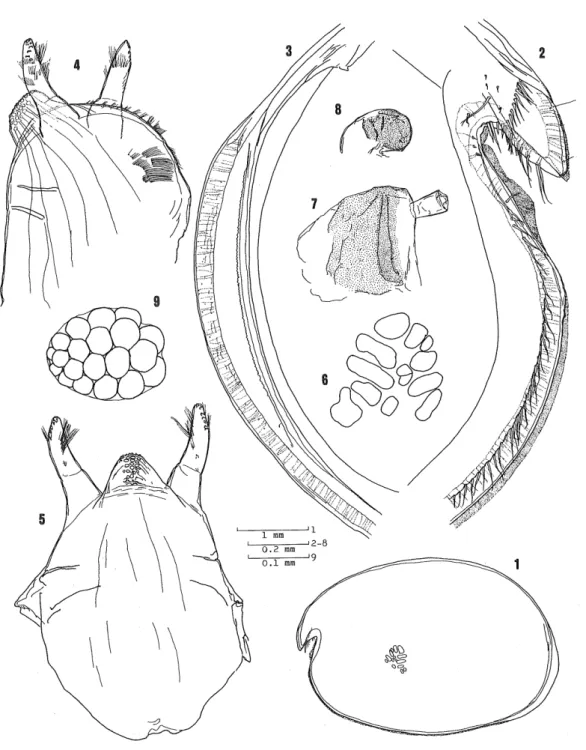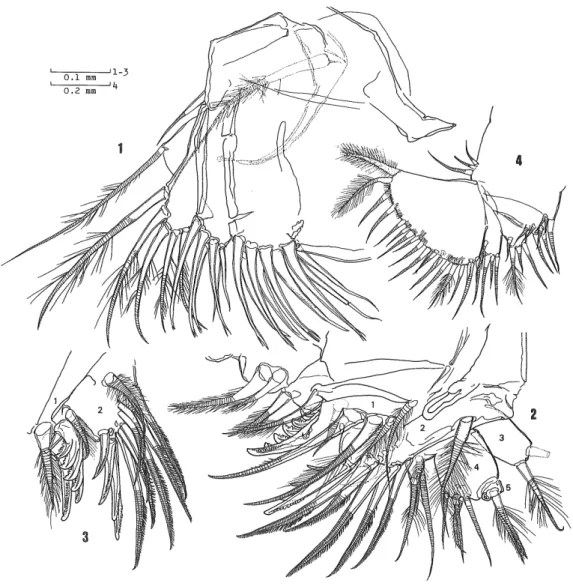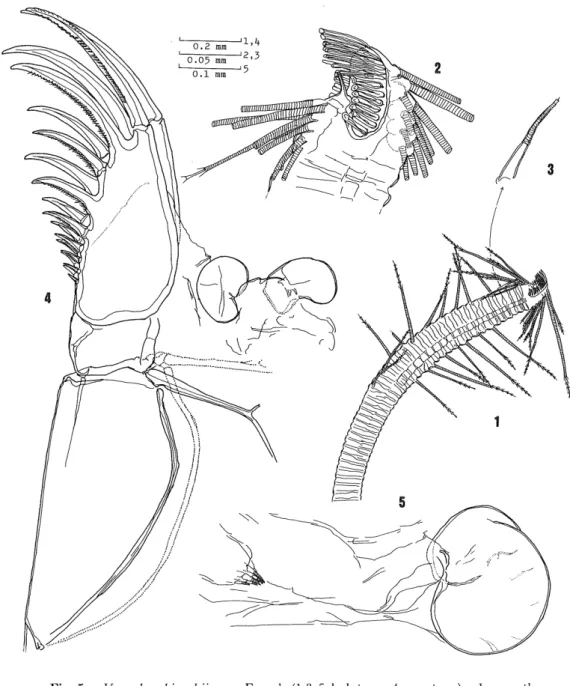日本産貝形虫Vargula属 (Myodocopina亜目) の一新種
全文
(2) Journal of Hokkaido University of Education (Section II B) Vol. 35, No. 1 September, 1984. -???ir^NBS (^2gpB) ^35^ 1U-?- Bgffi59^9J!. A New Species of the Genus Vargula from the Pacific Coast of Central Japan (Ostracoda : Myodocopina). Shinlchi HIRUTA Biological Laboratory, Kushiro College, Hokkaido University of Education, Kushiro 085. : B^tMff^A Vargula H, (Myodocopina S1. g). mDf^i. ^wmn^mw^w^ Abstract A new species of the genus Vargula is reported from Japan. The species is distinguishable from the congeneric species hitherto known mainly in the morphology of its seventh limb.. Introduction Up to the present, three species of the genus Vargula Skogsberg, 1920 have been recorded from Japan and its adjacent seas (Poulsen, 1962). The present paper deals with a new species of the genus from the Pacific coast of central Japan. The specimens (ten adult females and one juvenile male) were collected by using a baited trap (dead fish) during a survey of scavenging Crustacea by Dr. H. Sekiguchi of Mie University, and were placed at my disposal for a taxonomic study. The type specimens are deposited in the Zoological Institute, Faculty of Science, Hokkaido University. Before going further, I would like to express my thanks to Dr. H. Sekiguchi of Faculty of Fisheries, Mie University, who gave me the opportunity to examine the specimens reported in this paper.. (53).
(3) 54. Shinlchi HIRUTA. Fig. 1. Vargula sekiguchii sp. n. Female (1-4, 6-8. holotype ; 5. paratype). 1. lateral view of left valve ; 2. inside view of anterior part ; 3. inside view of posterior part ; 4. upper lip, lateral view ; 5. ditto, dorsal view : 6. adductor muscle scar ; 7. rod-shaped organ and median eye ; 8. lateral eye. Male (paratype ; A-l instar). 9. lateral eye.. (54).
(4) A New Species of Vargula, Ostracoda 55. Vargula sekiguchii sp. n.. (Figs. 1-5) Adult male unknown. Female. Carapace (Fig. 1-1—3) oval in lateral view, with deep incisur and narrow caudal process ; incisur with continuous margin. Infold broad along anterior to anteroventral margin and posterior margin ; ventral infold narrow ; a row of about ten bristles and some small spines. present on rostral infold ; about twenty bristles of different lengths present along ventral margin of rostrum ; one bristle and three or four spines present on anterior infold near incisur ;. anterior to anterior half of ventral infold with a row of many bristles ; posterior infold with a ridge which is almost parallel to posterior margin and is furnished with a serrate posterior margin. Selvage with lamellar prolongation. Adductor muscle scar (Fig. 1-1, 6) consisting of about thirteen individual muscle scars. Shell shape of male A—l instar is almost the same as that of female.. Size (mm) Holotype Paratype. 1. ^. 2 -^. 3. length. height. 3.55. 2.45. 3.60. 2.38. 3.20. 2.35. 3.18. 2.25. 4 -^. 3.50. 2.40. 5. 3.60. 2.25. -cT'(A-l). Upper lip (Fig. 1-4, 5) consisting of anterior impaired part and a pair of posterior tusks which are furnished with long hairs ; anteroventral margin with clusters of hairs. Rod-shaped organ and median eye (Fig. 1-7): rod-shaped organ short, slightly increasing in diameter distally, and terminating in a round tip ; median eye with dark brown pigments. Lateral eye (Fig. 1-8) small, with dark brown pigments but without ommatidia. Since lateral eye of A-l male (Fig. 1-9) has about twenty ommatidia, adult males of this species would seem to have well-developed lateral eyes. First antenna (Fig. 2-1, 2). First segment as long as second ; second segment with clusters of hairs on surface ; third segment about one-fourth length of second, with one anterior and one. posterior bristle ; fourth segment about twice as long as third, with one anterodistal and one posterodistal bristle ; fifth segment slightly shorter than fourth, with a long sensory bristle which is furnished with about eleven long filaments, and terminates in a bifurcate tip ; sixth segment about half length of fifth, with a short mediodistal bristle ; seventh and eighth segments not clearly detected ; seventh segment with short a-bristle, b-bristle which is about 2.5 times as long as.a-bristle and is furnished with several filaments, and c-bristle which is about three times as long as b-bristle and is furnished with long filaments ; eighth segment with d-, e-, f-, and g-bristles ; d- and e-bristles as long as b-bristle, without filaments ; f- and g-bristle similar to c-bristle.. Second antenna (Fig. 2-3 ~ 7). Protopodite with one medial bristle. Endopodite threesegmented ; first segment with one long subterminal bristle and four proximal bristles of which. (55).
(5) 56. Shinlchi HIRUTA. Fig. 2. Vargula sekiguchii sp. n. Female (1, 3, 4, 6. holotype ; 2, 5, 7. paratype). 1. first antenna ; 2. ditto, sensory bristle on fifth segment ; 3. second antenna, protopodite and endopodite ; 4, 5. ditto, endopodite ; 6. ditto, exopodite ; 7. ditto, bristle on second exopodite segment.. (56).
(6) A New Species of Vargula, Ostracoda 57. one is about three times as long as others ; second segment with one anterodistal bristle ; third segment three-fifths length of second, with one long distal bristle. Exopodite nine-segmented ; first segment as long as following segments combined ; third to ninth segments with basal spines which increase in size distally ; ninth segment with one short and three long bristles ; bristle on second segment furnished with teeth along anterior margin.. Mandible (Fig. 3-1—6). Coxale with one short bristle near coxale endite ; coxale endite semitriangular, with a bifurcate tip and a number of long spinules. Basale : two long slender bristles present near medioproximal margin ; ventral margin with one short proximal bristle. and four bristles in middle of margin, of which distalmost one is long and furnished with stiff hairs ; dorsal margin with three bristles, one proximal, two distal juxtaposed. Exopodite triangular, slightly longer than dorsal margin of first endopodite segment, with two subterminal bristles, of which proximal one is about twice as long as distal one, and fine hairs on distal half of dorsal surface. Endopodite : first segment with four ventral bristles of different lengths of which longest one is furnished with stiff hairs ; second segment six times as long as first, with three groups of bristles having one, one, and two bristles on ventral margin and about twenty. bristles of different lengths on proximal half of dorsal margin ; end segment small, with three claw-like bristles and four bristles of which ventral one is very short.. Maxilla (Fig. 3-7 ; Fig. 4-1). Coxale with one long dorsodistal bristle ; first endite with one proximal and five distal bristles ; second endite with seven distal bristles ; third endite with nine distal bristles ; all bristles on endites with stiff hairs. Basale with one bristle near base of exopodite. Endopodite : first segment with clusters of hairs on surface, two a -bristles, and. three /?-bristles ; outer /?-bristle stout and pectinate ; cutting edge consisting of a triangular tooth ; second segment small, with two claw-like bristles and nine bristles of different lengths, of which six are pectinate. Exopodite one-third the length of endopodite, with one hairy bristle on its outer margin and two terminal bristles.. Fifth limb (Fig. 4-2, 3). Epipodial appendage with about 60 bristles. Exopodite : lateral surface of first segment with five bristles of which posterior two are slender and hairy, while anterior three are stout ; one medial bristle present near base of main tooth ; main tooth consisting of six teeth and a proximal peg ; second segment with one pulmose posterior bristle, ten anterior bristles of which six are pectinate, and four anterior claw-like bristles ; inner lobe. of third segment with one proximal and two distal bristles ; outer lobe of third segment with two terminal bristles ; fourth segment quadrate, with four bristles on inner corner ; fifth segment small, with two bristles ; inner margin of fifth segment forms a small process.. Sixth limb (Fig. 4-4). Epipodial appendage with three bristles ; first endite with three bristles ; second endite with five bristles ; third endite with four bristles ; fourth endite with five bristles ; end segment hirsute, with 19 to 27 bristles and stiff hairs along ventral margin. Seventh limb (Fig. 5-1—3). Each limb with 17 to 21 proximal bristles, of which distalmost one on peg side pointing distally and annulated along distal half, and 17 to 22 distal bristles ; terminal comb with about seven elongate teeth ; five to seven short teeth present on each side of elongate teeth ; one short peg present opposite comb.. Ftirca (Fig. 5-4). Each lamella with nine claws ; claws 2 and 4 continuous with lamella ;. (57).
(7) 58 Shinlchi HIRUTA. Fis'3' ^es.^^^^,.^.,.. e=te^o^^IS^^. (58).
(8) A New Species of Vargula, Ostracoda. Fig. 4. Vargula sekiguchii sp. n. Female (holotype). 1. maxilla, endites ; 2. fifth limb, distal part (left), all bristles on endites not shown ; 3. ditto, main tooth (right) ; 4. sixth limb. others separated from lamella by suture. Genitalia and brusk-lile organ (Fig. 5-4, 5). A pair. of heart-shaped genitalia present in front of furca ; brush-like organ consisting of about se7en short bristles above genitalia. Remarks. The present new species is mainly characterized by the morphology of the seventh limb : the distalmost bristle of the proximal bristles on the peg side, as described above. has a unique structure in comparison with other cleaning bristles. This kind of bristle has been described as a dorsal spine or dorsal jaw (Poulsen, 1962 ; Kornicker, 1975) and is regarded'as a transformed cleaning bristle. Among the members of the genus Vargula, only four species. possess this type of bristle on the seventh limb : V. spinosa Poulsen, 1962, V. spinulosa Poulsen.. (59). 59.
(9) 60. Shinlchi HIRUTA. 1962, V. tubulata Poulsen, 1962, V?. danae (Brady, 1880). The bristles of V. spinosa, V. tubulata, and V?. danae, however, are much stouter than that of the present new species. Furthermore, although the bristle of V. sekiguchii sp. n. resembles that of V. spinulosa in general appearance,. the former is without a number of the stiff spine-like hairs which are found in the latter. In addition, the furcal claws 2 and 4 are united to the lamella in V. sekiguchii, whereas in V.. Fig. 5. Vargula sekiguchii sp. n. Female (1-3, 5. holotype ; 4. paratype). 1.seventh limb ; 2. ditto, distal part ; 3. ditto, distalmost bristle of proximal bristles of peg side ; 4. furca and genitalia ; 5. genitalia and brush-like organ.. (60).
(10) A New Species of Vargula, Ostracoda 61. spinulosa, only claw 2 is united to the lamella. The present new species is thus clearly distinguishable from the congeneric species so far known. Specimens examined. Holotype -?- ; paratypes 4 ^- ^- and 1 (A-l instar) cf (17-IX-'81). The name of the species was selected in honour of Dr. H. Sekiguchi of M^ie University. Locality. 34° 21.0' N, 137° 59.5/ E ; depth 520 m.. References. Kornicker, L. S. 1975. Antarctic Ostracoda (Myodocopina). Smiths. Contr. Zool. 163 : 1-720. Poulsen, E. M. 1962. Ostracoda-Myodocopa ; Part 1. Cypridiniformes-Cypridinidae. Dana Reports 57 : 1 414.. (61).
(11)
図




関連したドキュメント
˙Ibrahim C¸anak: Department of Mathematics, Adnan Menderes University, 09010 Aydın, Turkey Email address: icanak@adu.edu.tr. Umit Totur: Department of Mathematics, Adnan
We establish different fundamental inequalities on a class of multistructures, more precisely Poincaré’s inequality for second and fourth order (scalar) opera- tors as well as
From the second, third and fourth rows, we assert that predator–prey systems with harvesting rate on the prey species have similar dynamical behav- iors around its positive
As a consequence of this characterization, we get a characterization of the convex ideal hyperbolic polyhedra associated to a compact surface with genus greater than one (Corollary
In addition, under the above assumptions, we show, as in the uniform norm, that a function in L 1 (K, ν) has a strongly unique best approximant if and only if the best
We focus on a certain class of oscillating poten- tials (larger than the one in [GJ2]) that was already studied in [BD, DMR, DR1, DR2, MU, ReT1, ReT2]. Allowing long-range
Wro ´nski’s construction replaced by phase semantic completion. ASubL3, Crakow 06/11/06
Using this result and a generalised bracket polynomial, we develop methods that may determine whether a virtual knot diagram is non-classical (and hence non-trivial).. As examples